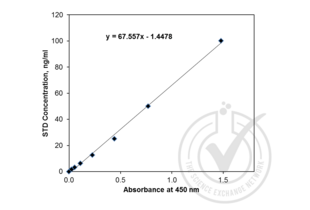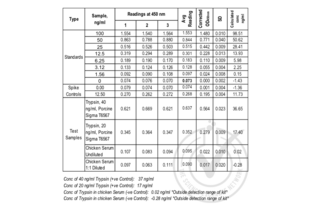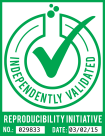Trypsin ELISA Kit
-
- Target Alle Trypsin ELISA Kits anzeigen
- Trypsin
-
Reaktivität
- Schwein
- Nachweismethode
- Colorimetric
- Methodentyp
- Sandwich ELISA
- Detektionsbereich
- 1.56 ng/mL - 100 ng/mL
- Untere Nachweisgrenze
- 1.56 ng/mL
- Applikation
- ELISA
- Verwendungszweck
-
The kit is a sandwich enzyme immunoassay for in vitro quantitative measurement of trypsin in porcine serum, plasma, tissue homogenates, cell lysates, cell culture supernates.
We offer validation data (WB) for the kit components. So you can be sure to order a reliable ELISA kit product composed of high quality reagents. - Proben
- Cell Culture Supernatant, Cell Lysate, Plasma, Serum, Tissue Homogenate
- Analytische Methode
- Quantitative
- Spezifität
-
This assay has high sensitivity and excellent specificity for detection of Trypsin (TRY).
No significant cross-reactivity or interference between Trypsin (TRY) and analogues was observed. - Kreuzreaktivität (Details)
- No significant cross-reactivity or interference between Trypsin (TRY) and analogues was observed.
- Sensitivität
- 0.62 ng/mL
- Bestandteile
-
- Pre-coated, ready to use 96-well strip plate, flat buttom
- Plate sealer for 96 wells
- Reference Standard
- Standard Diluent
- Detection Reagent A
- Detection Reagent B
- Assay Diluent A
- Assay Diluent B
- Reagent Diluent (if Detection Reagent is lyophilized)
- TMB Substrate
- Stop Solution
- Wash Buffer (30 x concentrate)
- Instruction manual
- Top Product
- Discover our top product Trypsin ELISA Kit
-
-
- Applikationshinweise
-
- Limited by the current condition and scientific technology, we cannot completely conduct the comprehensive identification and analysis on the raw material provided by suppliers. So there might be some qualitative and technical risks to use the kit.
- The final experimental results will be closely related to validity of the products, operation skills of the end users and the experimental environments. Please make sure that sufficient samples are available.
- Kits from different batches may be a little different in detection range, sensitivity and color developing time.
- Do not mix or substitute reagents from one kit lot to another. Use only the reagents supplied by manufacturer.
- Protect all reagents from strong light during storage and incubation. All the bottle caps of reagents should be covered tightly to prevent the evaporation and contamination of microorganism.
- There may be some foggy substance in the wells when the plate is opened at the first time. It will not have any effect on the final assay results. Do not remove microtiter plate from the storage bag until needed.
- Wrong operations during the reagents preparation and loading, as well as incorrect parameter setting for the plate reader may lead to incorrect results. A microplate plate reader with a bandwidth of 10nm or less and an optical density range of 0-3 O.D. or greater at 450 ± 10nm wavelength is acceptable for use in absorbance measurement. Please read the instruction carefully and adjust the instrument prior to the experiment.
- Even the same operator might get different results in two separate experiments. In order to get better reproducible results, the operation of every step in the assay should be controlled. Furthermore, a preliminary experiment before assay for each batch is recommended.
- Each kit has been strictly passed Q.C test. However, results from end users might be inconsistent with our in-house data due to some unexpected transportation conditions or different lab equipments. Intra-assay variance among kits from different batches might arise from above factors, too.
- Kits from different manufacturers for the same item might produce different results, since we have not compared our products with other manufacturers.
- Kommentare
-
Information on standard material:
The standard might be recombinant protein or natural protein, that will depend on the specific kit. Moreover, the expression system is E.coli or yeast or mammal cell. There is 0.05% proclin 300 in the standard as preservative.
Information on reagents:
The stop solution used in the kit is sulfuric acid with concentration of 1 mol/L. And the wash solution is TBS. The standard diluent contains 0.02 % sodium azide, assay diluent A and assay diluent B contain 0.01% sodium azide. Some kits can contain is BSA in them.
Information on antibodies:
The provided antibodies and their host vary in different kits. - Probenmenge
- 100 μL
- Testdauer
- 3 h
- Plattentyp
- Pre-coated
- Protokoll
- The test principle applied in this kit is Sandwich enzyme immunoassay. The microtiter plate provided in this kit has been pre-coated with an antibody specific to Trypsin (TRY). Standards or samples are then added to the appropriate microtiter plate wells with a biotin-conjugated antibody specific to Trypsin (TRY). Next, Avidin conjugated to Horseradish Peroxidase (HRP) is added to each microplate well and incubated. After TMB substrate solution is added, only those wells that contain Trypsin (TRY), biotin-conjugated antibody and enzyme-conjugated Avidin will exhibit a change in color. The enzyme-substrate reaction is terminated by the addition of sulphuric acid solution and the color change is measured spectrophotometrically at a wavelength of 450nm ± 10nm. The concentration of Trypsin (TRY) in the samples is then determined by comparing the O.D. of the samples to the standard curve.
- Aufbereitung der Reagenzien
-
- Bring all kit components and samples to room temperature (18-25 °C) before use. If the kit will not be used up in one time, please only take out strips and reagents for present experiment, and leave the remaining strips and reagents in required condition.
- Standard - Reconstitute the Standard with 1.0 mL of Standard Diluent, keep for 10 minutes at room temperature, shake gently (not to foam). The concentration of the standard in the stock solution is 800 ng/mL. Firstly dilute the stock solution to 100 ng/mL and the diluted standard serves as the highest standard (100 ng/mL). Then prepare 7 tubes containing 0.5 mL Standard Diluent and use the diluted standard to produce a double dilution series. Mix each tube thoroughly before the next transfer. Set up 7 points of diluted standard such as 100 ng/mL, 50 ng/mL, 25 ng/mL, 12.5 ng/mL, 6.25 ng/mL, 3.12 ng/mL, 1.56 ng/mL, and the last microcentrifuge tube with Standard Diluent is the blank as 0 ng/mL.
- Detection Reagent A and Detection Reagent B - If lyophilized reconstitute the Detection Reagent A with 150μL of Reagent Diluent, keep for 10 minutes at room temperature, shake gently (not to foam). Briefly spin or centrifuge the stock Detection A and Detection B before use. Dilute them to the working concentration 100-fold with Assay Diluent A and B, respectively.
- Wash Solution - Dilute 20 mL of Wash Solution concentrate (30x) with 580 mL of deionized or distilled water to prepare 600 mL of Wash Solution (1x).
- TMB substrate - Aspirate the needed dosage of the solution with sterilized tips and do not dump the residual solution into the vial again.
Note:
- Making serial dilution in the wells directly is not permitted.
- Prepare standards within 15 minutes before assay. Please do not dissolve the reagents at 37 °C directly.
- Please carefully reconstitute Standards or working Detection Reagent A and B according to the instruction, and avoid foaming and mix gently until the crystals are completely dissolved. To minimize imprecision caused by pipetting, use small volumes and ensure that pipettors are calibrated. It is recommended to suck more than 10μL for one pipetting.
- The reconstituted Standards, Detection Reagent A and Detection Reagent B can be used only once.
- If crystals have formed in the Wash Solution concentrate (30x), warm to room temperature and mix gently until the crystals are completely dissolved.
- Contaminated water or container for reagent preparation will influence the detection result.
- Testpräzision
-
Intra-assay Precision (Precision within an assay): 3 samples with low, middle and high level Trypsin (TRY) were tested 20 times on one plate, respectively.
Inter-assay Precision (Precision between assays): 3 samples with low, middle and high level Trypsin (TRY) were tested on 3 different plates, 8 replicates in each plate.
CV(%) = SD/meanX100
Intra-Assay: CV<10%
Inter-Assay: CV<12%
- Beschränkungen
- Nur für Forschungszwecke einsetzbar
-
- by
- Alamo Laboratories
- No.
- #029833
- Datum
- 02.03.2015
- Antigen
- Chargennummer
- L141028604
- Validierte Anwendung
- ELISA
- Positivkontrolle
- Trypsin from porcine pancreas
- Negativkontrolle
- Chicken serum (non-reactive species)
- Bewertung
- Target protein was detected in the positive control sample and not in the negative control sample as expected.
- Primärantikörper
- Sekundärantikörper
- Full Protocol
- 1. All reagents in the ELISA kit were brought up to room temperature (RT) before use.
- 2. 100 μL of standard or sample were added to wells in ELISA plate pre-coated with capture antibody.
- 3. All samples and standards were assayed in triplicate.
- 4. The plate was covered with sealer (provided in kit) and incubated for 2 hours at 37°C. Unbound material was aspirated but the wells were NOT washed.
- 5. 100 μL of Detection Reagent-A Working Solution was added to each well. Plate was covered with sealer (provided in kit) and incubated for 1 hour at 37°C. Unbound material was removed from each well and plate was washed three times with 350 μL of 1x Wash Solution (provided in the kit). After the last wash the plate was inverted and blotted against clean absorbent paper to remove any remaining liquid.
- 6. 100 μL of Detection Reagent-B Working Solution was added to each well. Plate was covered with sealer (provided in kit) and incubated for 30 minutes at 37°C.
- 7. Unbound material was removed by washing five times with 350 μL of 1x Wash Solution (provided in the kit). After the last wash the plate was inverted and blotted against clean absorbent paper to remove any remaining liquid.
- 8. 90 μL of Substrate Solution was added to wells and the plate was covered with a new plate sealer. The plate was gently tapped to ensure mixing and incubated for 25 minutes at 37°C in the dark.
- 9. After 25 minutes, when an apparent gradient appeared in the standard wells, the reaction was terminated by adding 50 μL of Stop Solution to each well.
- 10. The optical density (OD value) of each well was read using a microplate reader set to 450 nm.
- 11. The triplicate readings for each sample were averaged and the average zero standard optical density subtracted to yield ‘corrected absorbance at 450 nm’. A standard curve was generated by plotting the mean OD value for each standard on the X-axis against the concentration on the Y-axis using Excel. Standard curve was generated by regression analysis.
- 12. An equation (y = 67.557x - 1.4478) was derived from the standard curve and used to calculate trypsin concentrations in samples based on their Average Absorbance values.
- Anmerkungen
- The positive control was trypsin from porcine pancreas (Sigma-Aldrich Catalog # T6567). As per instruction from the manufacturer, the trypsin powder should be dissolved in 1 mM HCl. However, the acid solublization process renders the sample almost undetectable by the kit. Therefore trypsin powder was dissolved in STANDARD diluent (provided in the kit) by rocking the mixture for 30 minutes at room temperature.
Validierung #029833 (ELISA)![Erfolgreich validiert 'Independent Validation' Siegel]()
![Erfolgreich validiert 'Independent Validation' Siegel]() Validierungsbilder
Validierungsbilder![Figure 2: Table of absorbance values for standard curve, spike control and samples.
Value for Avg Reading is derived from the average reading of three samples. Avg Reading for “0” amount of Standard was subtracted from all Avg Readings to yield “Corrected OD450 nm values” for Standards, spike controls and unknown samples. Standard deviation is included for all samples.]() Figure 2: Table of absorbance values for standard curve, spike control and samples.
Value for Avg Reading is derived from the average reading of three samples. Avg Reading for “0” amount of Standard was subtracted from all Avg Readings to yield “Corrected OD450 nm values” for Standards, spike controls and unknown samples. Standard deviation is included for all samples.
Protokoll
Figure 2: Table of absorbance values for standard curve, spike control and samples.
Value for Avg Reading is derived from the average reading of three samples. Avg Reading for “0” amount of Standard was subtracted from all Avg Readings to yield “Corrected OD450 nm values” for Standards, spike controls and unknown samples. Standard deviation is included for all samples.
Protokoll -
- Vorsichtsmaßnahmen
- The Stop Solution suggested for use with this kit is an acid solution. Wear eye, hand, face, and clothing protection when using this material.
- Handhabung
-
The stability of kit is determined by the loss rate of activity. The loss rate of this kit is less than 5 % within the expiration date under appropriate storage condition.
To minimize extra influence on the performance, operation procedures and lab conditions, especially room temperature, air humidity, incubator temperature should be strictly controlled. It is also strongly suggested that the whole assay is performed by the same operator from the beginning to the end. - Lagerung
- 4 °C
- Informationen zur Lagerung
-
- For unopened kit: All the reagents should be kept according to the labels on vials. The Standard, Detection Reagent A, Detection Reagent B and the 96-well strip plate should be stored at -20°C upon receipt while the others should be at 4°C.
- For opened kit: When the kit is opened, the remaining reagents still need to be stored according to the above storage condition. Besides, please return the unused wells to the foil pouch containing the desiccant pack, and reseal along entire edge of zip-seal.
Note: It is highly recommended to use the remaining reagents within 1 month provided this is within the expiration date of the kit. - For ELISA kit, 1 day storage at 37°C can be considered as 2 months at 4°C, which means 3 days at 37°C equaling 6 months at 4°C.
- Haltbarkeit
- 6 months
-
- Target Alle Trypsin ELISA Kits anzeigen
- Trypsin
- Abstract
- Trypsin Produkte
-



 (1 Validierung)
(1 Validierung)



